Naturalist’s Notebook: April 23, 2016 to April 29, 2016
It is important to remember that whalewatching is not just about whales. It always best to think of your trip as a Marine Science Adventure. The reason for that is very simple. Sometimes the coolest thing that you experience is not something that the whales were doing. A whalewatch is a foray into what may be, for most people, an entirely new world. For starters, the floor doesn’t stay still. There are new rules for standing and walking. There are new smells. The weather feels different. It is very much a different world.
April 23 was one such day. Both trips viewed 2 or even 3 species of baleen whales and a half dozen or more species of birds. But the standout experience of the day was the sighting of a harbor seal that spent a little time pushing a sizeable branch around with the back of its head. The seal was oriented upright in the water, with its head above the surface and its nose pointed at the sky. The back of its head and neck were resting against the log. It looked, briefly, to be moving its head back and forth, but the reporting naturalist couldn’t be sure if the animal was scratching its neck on the branch or not. Just like whales, seals are mammals and, as such, will become curious about things in their environment. They have been seen playing with seaweed and sticks and buckets and fish totes.
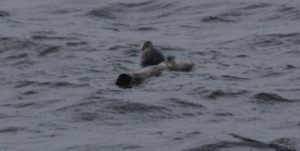
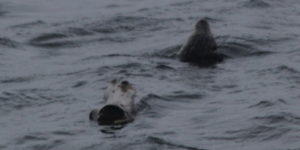
It was cold on April 24. The half dozen or so juvenile humpback whales sighted throughout the day were spending time in shallow water and not even lifting their flukes up when they dove. At one point, though, one of them breached. A tailbreach is when the whale throws the back end of its body up out of the water without seeming to care where it comes back down. As opposed to lobtailling, which is a very controlled lifting of the flukes and tailstalk above the surface before slamming it back down. Mark Gilmore says that the highpoint of the day was standing by a potentially entangled whale while the Center for Coastal Studies’ rapid response boat worked its way to the area.
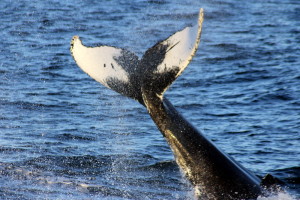
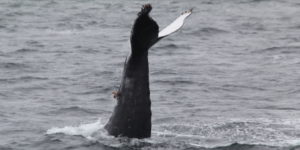
Entanglement in fishing gear has become an increasing problem for cetaceans and other marine species. Nearly seventy-five percent of the humpbacks in the study population show signs of being entangled in gear. Ther problem is not the fishermen. They are working very hard to make a living to support their families and to do so responsibly. Nobody goes out on their boat thinking, “I am going to entangle a whale today.” The problem is that whales and fishermen are trying to make their livings in the same place.
What is needed is technology that will allow us to fish without having ropes that lead from the gear to the surface, technology that is not only effective but also that can be made readily available and inexpensive enough to allow the fishermen to afford them. It also needs to be user serviceable so the fishermen can fix it.
In fact, if you are coming whalewatching on the Dolphin Fleet and have an idea that might fill those needs, write it down with your name and email address. Give it to your naturalist. We are not looking to take your ideas. I will put them into the hands of people that will no better than I if your idea should be further developed. If you are under 18 please get your parents’ permission before leaving any information.
April 25 was a beautiful, sunny day with a little bit of a breeze. A small number of juvenile humpbacks were still to be found between Wood End and Race Point. But out several miles from the Point along the mouth of Cape Cod Bay was something big making a lot of white water. A single humpback whale was sighted, still ing the distance, lifting its long, white pectoral flipper above the surface of the water and bringing it crashing down to cause those splashes. With the 10 knot speed limit still in place, it took quite some time for the Dolphin VIII to get to the place where the whale was. It was not a wasted trip. The whale continued to flipperslap and breach for the entire time we were with it and still once we had departed.
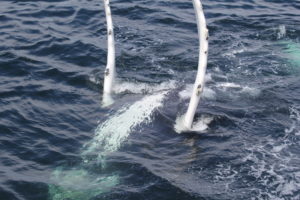
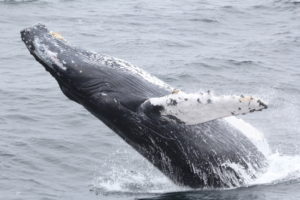
Also on this day, a dead whale was found floating on the far side of the bay. The Dolphin VIII’s passengers did not see the whale but it does warrant a quick mention. When a whale dies, its internal organs begin to decompose, often causing the body to fill up with gas and float to the surface. If the carcass is found, it might be towed to shore so that a necropsy can be performed to determine the cause of death and many other important pieces of information. If it’s not found, the gas will eventually find its way out of the carcass and the whale will sink to the bottom. A whale carcass that falls to the bottom is referred to as a whalefall.
If you think of a whalefall kind of like a tree that has fallen in the woods, you can easily see what a tremendous opportunity this is for other living creatures. First, it creates a new local food source, a huge food source that would be of value to sharks and fish and crabs (mobile scavengers) that would feed on the flesh, but also to a myriad of other creatures that specialize on feeding on things like the lipid-rich bones. Once these two phases are complete, there are bacteria that specialize in using chemical enery to create food from nutrients in the environment similarly to the way plants utilize the light energy of the sun to photosynthesize it. As many as two hundred different species may continue to utilize the remains for as long as twenty years. From the first phase to the last, there are more than sixty species that are only found on whalefalls (and nowhere else).
Also, just like that tree that fell in the woods, a whalefall creates a new habitat, a new home for unlimited numbers of species. All of a sudden, there is a new reef to provide shelter and protection to creatures that may feed either on the remains or on the other creatures that come there to feed on the carcass. Whalefalls may also play an important role in the migration of species from one thermal vent to another.
In short, whalefalls are another reason why the recovery of whale populations is necessary for the recovery of the ocean.
On April 27, some of those juvenile humpback whales were finally seen feeding near Race Point. These individuals have been sighted from the whalewatches nearly every day but any feeding they were doing while the Dolphin VIII was nearby was beneath the surface enough that it was not evident. Today, however, they were employing a method called kickfeeding. Essentially, the whale blows its bubbles (a single cloud or a several columns) and then lobtails over them. The bubbles kind of create the walls of a feeding corridor that concentrate the forage fish in the center and push them toward the surface. The lobtailling above them makes new bubbles that concentrate the fish vertically. If you think of it like a cup, the bubbles the whale blows form the sides and bottom of the cup and the bubbles that are caused by the slapping of the flukes (tails) are kind of like the lid to the sippy cup that prevent what’s inside from spilling out over the top.

When a whale creates bubbles to corral its forage fish, it temporarily changes the environment of the water it is feeding in, much like a beaver engineering a dam. This temporary environment may last only a minute or two, compared to the beaver’s lake that might last a decade or even more, but it is a newly engineered environment, intentionally created by the whale for a specific purpose. But the whale is not the only beneficiary. Yes, the whale makes its feeding effort far more efficient. But the motion of the bubbles and the whale vertically through the water column also creates a temporary upwelling in which ntrients that had settled deeper in the water are brought back to the surface. These nutrients can now be used to fuel the photosynthesis of the phytoplankton. And the action of the flukes serves not just to mix the waters but also to add carbon dioxide and oxygen from the atmosphere. It would be interesting to look into whether or not an area where a whale has been kickfeeding in the morning was more productive for plankton in the next several hours or days.
In fact, if you are coming whalewatching on the Dolphin Fleet and you have ideas about how this might be studied effectively, write them down and give them to your naturalist with your name and email address. If you are under 18, please get your parents’ permission before leaving any information.
Friday the 29th was “cold but beautiful.” Humpback whales were sighted again today. Some of them did begin to feed near the surface while the Dolphin VIII was there, consuming the thick balls of forage fish like sand eels that were easily seen beneath the surface.
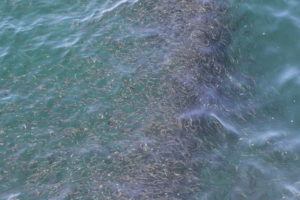
Right whales were also seen feeding. If feeding humpback whales mix the water vertically, then feeding right whales mix the water horizontally. Right whales skimfeed. They open their mouths and move slowly through the water as copepods are collected in the very fine filaments of their baleen. As they move along concentrated lines of zooplankters, they might be dragging necessary nutrients in their wakes. Nutrients that the phytoplankton utilize. If they are dragging nutrients from the outside of the zooplankton concentration to the inside, they could, in theory, be enhancing the phytoplankon bloom that feeds the zooplankton.
OK. With the last couple of ideas, I am just thinking outloud. Yes, whales coming to the surface do create a temporary upwelling. That can be measured. Whether or not that temporarily enhances a plankton bloom has not been studied so far as I know. The same is true for whether or not the movements of a right whale temporarily enhance or concentrate plankton. If they do have influences on the plankton populations, no matter how temporary, it is more evidence that the health of the ocean environment is further tied to the health of the whale populations.





